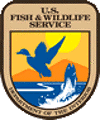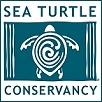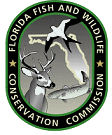During late July and August 1998 and 1999, researcher Barbara Schroeder (National Marine Fisheries Service) and Allen Foley (Florida Department of Environmental Protection), attached satellite transmitters to five loggerhead sea turtles in Florida. Three transmitters were attached to turtles on the Gulf coast near Manasota Key with the assistance of the Manasota Key Sea Turtle Patrol. The other two transmitters were placed on turtles that had nested in the Archie Carr National Wildlife Refuge near Melbourne, Florida with the assistance of Dr. Llew Ehrhart and his students (University of Central Florida). The research is aimed at locating principle foraging grounds and migratory routes used by Florida’s loggerhead sea turtles.
During August 2000, Sandra MacPherson (National Sea Turtle Coordinator, U.S. Fish and Wildlife Service) and Barbara Schroeder (National Sea Turtle Coordinator, NOAA, National Marine Fisheries Service) attached satellite transmitters to loggerhead turtles in Florida. Five transmitters were placed on turtles that had nested in the Archie Carr National Wildlife Refuge near Melbourne, Florida, with the assistance of Dr. Llew Ehrhart and his students (University of Central Florida). Florida beaches account for 90 percent of loggerhead nesting in the southeastern United States, a population that is the largest in the western hemisphere and one of the two largest in the world. Visitors to this site will be able to follow these five turtles by clicking a name below.
This tracking project is aimed at locating the migratory routes and principle foraging habitats of Florida loggerheads after they nest. The collected data will help identify the threats that sea turtles may encounter while traveling to and from their nesting beaches and while residing at their foraging areas. This information will be of vital importance to the U.S. Fish and Wildlife Service and the National Marine Fisheries Service in determining where international cooperative efforts should be focused to ensure recovery of our shared sea turtle resources.
Similar tracking experiments conducted by Barbara Schroeder on green sea turtles during the past four years yielded exciting new information about where female sea turtles travel after nesting on Florida’s east coast. See the section titled “Results of 1994 & 1995 Migration-Tracking of Florida Green Turtles”, “Results from 1996 Migration Tracking” and “Results from 1997 Green Tracking Project” for more details.
 |
 |
 |
 |
The U.S. Fish and Wildlife Service and National Marine Fisheries Service would like to thank Dr. Llew Ehrhart and his students, University of Central Florida, for their assistance with this project.
For more information on sea turtles, check out the Sea Turtles Information section of our website.
Click on the turtle’s name to see a map of its movements.
Turtles Tagged in 2000
PERCEID – Perceid was first encountered at 9:50p.m. on August 10, 2000, while covering a nest laid at the Archie Carr National Wildlife Refuge during the Perceid meteor shower. A satellite tag was applied after she finished nesting. Perceid measured 98.4 cm in curved carapace (shell) length.
KAME SAN – Kame san was first encountered at 1:00a.m. on August 11, 2000, while digging an egg chamber at the Archie Carr National Wildlife Refuge. A satellite tag was applied after she finished nesting. Kame san measured 100.8 cm in curved carapace (shell) length.
STAR – Star was first encountered at 10:00p.m. on August 11, 2000, while laying eggs at the Archie Carr National Wildlife Refuge. A satellite tag was applied after she finished nesting. Star measured 100.2 cm in curved carapace (shell) length.
PATIENCE – Patience was first encountered at 10:15p.m. on August 11, 2000, while digging a body pit prior to laying eggs at the Archie Carr National Wildlife Refuge. A satellite tag was applied after she finished nesting. Patience measured 93.7 cm in curved carapace (shell) length.
EUNICE – Eunice was first encountered at 10:28p.m. on August 12, 2000, while she was emerging onto the beach at the Archie Carr National Wildlife Refuge. A satellite tag was applied after she finished nesting. Eunice measured 97.7 cm in curved carapace (shell) length.
On the night of June 4th, 2002, researchers from the University of Central Florida were successful in locating Eunice while she was nesting in the Archie Carr National Wildlife Refuge. Biologist Blair Witherington (Florida Marine Research Institute) outfitted Eunice with a new satellite transmitter to see if she repeats the same post-nesting season movements. Unfortunately, data from the new transmitter may not be available on the web site.
UPDATE – Eunice is almost back to her foraging grounds! On Friday, August 9, 2002 she was between the Marquesas and the Dry Tortugas. On Saturday, August 10, 2002 she was due north of the Dry Tortugas. So, it looks like Eunice will be at her foraging grounds in a day or two!
Turtles Tagged in 1999
While scouting for turtles at the Archie Carr National Wildlife Refuge, researchers came across an old friend, a green turtle named Marjorie. Marjorie had been satellite tagged in 1997 and finding her again in 1998 gave researchers an opportunity to test a new type of transmitter and the chance to follow the same turtle for a second year.
DELTA – Delta is a female loggerhead that was first tagged on August 17, 1999 on the Archie Carr National Wildlife Refuge.
KAREN – Karen was first encountered nesting on August 18, 1999, on the Archie Carr National Wildlife Refuge. She had one tag scar, indicating that she had likely been encountered nesting on the Carr refuge during a previous nesting season but had since lost her tags. A satellite tag and flipper tags were applied after she finished nesting. Karen measured 99.1 cm in curved carapace (shell) length.
SANDY – Sandy was first encountered nesting on August 18, 1999, on the Archie Carr National Wildlife Refuge. A satellite tag and flipper tags were applied after she finished nesting. Sandy measured 107.8 cm in curved carapace (shell) length.
FRANCIS – Francis was first flipper tagged on May 10, 1999, when she was discovered nesting on the Archie Carr National Wildlife Refuge by the University of Central Florida marine turtle group. She had two tag scars, which likely means she had been encountered nesting at the Carr refuge during a previous nesting season but had since lost her tags. On August 19, Francis again was encountered on the refuge, and a satellite tag was applied after she finished nesting. Francis measured 100.7 cm in curved carapace (shell) length.
DESTINY – Destiny was first flipper tagged on June 20, 1999, when she was discovered nesting on the Archie Carr National Wildlife Refuge by the University of Central Florida marine turtle group. On August 19, she was encountered on the refuge, and a satellite tag was applied after she finished nesting. Destiny was made a celebrity by several television news stations and newspapers that covered her satellite tag application. She measured 102.0 cm in curved carapace (shell) length.
Thanks to Sakona Ly of Orlando, Florida for suggesting the name Destiny. And thanks to the over 300 people who submitted a suggestion.
Turtles Tagged in 1998
While scouting for turtles at the Archie Carr National Wildlife Refuge, researchers came across an old friend, a green turtle named Marjorie. Marjorie had been satellite tagged in 1997 and finding her again in 1998 gave researchers an opportunity to test a new type of transmitter and the chance to follow the same turtle for a second year.
JUANITA – Juanita is a female loggerhead that was first tagged on July 9, 1998 when she was discovered nesting on Manasota Key, FL (between Venice and Englewood, FL) by the Manasota Key Sea Turtle Patrol. On July 30th, Juanita was again encountered nesting on Manasota Key, and a satellite tag was applied after she finished nesting. Juanita measured 92.3 cm in carapace (shell) length. Juanita has headed straight out into the Gulf of Mexico and has begun to heading north towards the coast of Texas. Juanita remains in the northwestern Gulf and continues to transmit well, with regular, excellent quality locations, though perhaps slightly fewer points than before.
CASSIE – Of the three adult female loggerheads that we are tracking from the southwest coast of Florida this year, Cassie was the only one who was seen nesting in a previous year. Cassie was first encountered nesting on Casey Key, FL (just north of Venice, FL ) in June of 1994. She was tagged at that time by biologists from Mote Marine Laboratory. Cassie wasn’t seen again until 1998, when she nested on Casperson Beach (northern Manasota Key, just south of Venice) during the early morning hours of July 31st. After she finished nesting, a satellite tag was applied and she was released. Cassie measured 94.5 cm in carapace (shell) length. After traveling a short distance off shore into the Gulf of Mexico, Cassie seems to have found a nice spot to hang out. Cassie remains right where she went to the northwest of Tampa/St. Pete. She is still transmitting very well, with regular high quality locations.
SARA – Sara was first tagged on July 26, 1998 when she was discovered nesting on Manasota Key, FL. Sara was again encountered nesting on August 5th on Manasota Key (this time on Casperson Beach, northern Manasota Key) and a satellite tag was applied after she finished nesting. Sara measured 91.4 cm in carapace (shell) length. Check out her map as she made her way around Cuba and headed for Mexico! She remains north of the Mexican Yucatan Peninsula. Sara continues to transmit well, with regular locations.
GOODY TWO SHOES – Goody was first observed nesting on July 22nd at the Archie Carr National Wildlife Refuge in Brevard County, FL. She was seen again on August 9th at the Refuge and her satellite tag was applied after she finished nesting. Goody measured 83.7 cm in carapace (shell) length. Goody has headed straight north along the coast and has past Cape Canaveral. She remains just offshore northeast Florida and continues to transmit well. Goody’s signals are regular, good quality locations.
SCARLET – Scarlet, one of the two loggerheads being tracked from the east coast of Florida, was first encountered nesting on June 5th at the Archie Carr National Wildlife Refuge in Brevard County, FL. She was observed re-nesting at the Refuge on August 11th and a satellite tag was attached after she finished nesting. Scarlet measured 88.4 cm in carapace (shell) length. While Goody went straight north, Scarlet could not make up her mind. First she headed south, then turned north. Now she has headed south and is currently traveling off the coast of Cuba! She remains in the southwestern Bahamas and is not moving. Scarlet is continuing to transmit well, though the signals appear to have declined slightly in the quality of the positions, but overall they are still good.
MARJORIE – Marjorie is an old friend. She was first observed by the UCF Marine Turtle Research Group in 1991, then again in 1993, 1997, and once in 1998 when her first satellite tag was attached. This year a new satellite tag was attached to Marjorie’s back on August 10, after she laid a clutch of eggs. Marjorie’s nesting behavior is very unusual for a green sea turtle. Green sea turtles usually nest every two years, so Marjorie was not expected back until next year. It seems that Marjorie has followed the same path as last year. To see her movements from last year, click here.
Funding for the Florida Atlantic Coast Turtle Satellite Tracking Project was provided by the U.S. Fish and Wildlife Service and the NOAA/National Marine Fisheries Service. Maps created by the Sea Turtle Conservancy.